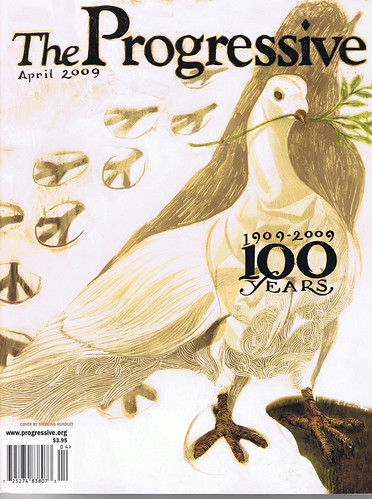Reality, La Follette's Weekly Magazine was not The Progressive. If you doubt that, turn to page 30, "1929," where a December 17, 1929 article is excerpted (for two sentences) and declares, "The Progressive Publishing Company is the name of a new organization which has been incorporated with a capital stock of $25,000 and which will publish a new weekly to be called The Progressive. The new publication will succeed La Follette's Magazine." What did they announce in 1929? That La Follette's was shutting down and "a new weekly to be called The Progressive" would "succeed La Follette's Magazine." Not a continuation, not a name switch, a new publication. A new weekly. The Progressive won't be 100 years old until 2029.
Reality, the anniversary issue is a bad, bad issue.
Each year gets one page.
Nothing gets context.
If you're really lucky, you read a few sentences by a member of Congress. If they were a member of Congress when they wrote the article the excerpt comes from, they will be identified as such. Otherwise, you don't know who these people are or why you're supposed to care. One exception is: Supreme Court Justice Louis Brandeis' daughter Susan Brandeis gets a slug explaining who she was or at least that she was someone's daughter. But being a Supreme Court Justice yourself doesn't appear to help, as is evidenced by the Abe Fortas excerpt which makes no mention that he would go on to serve on the Supreme Court. Charles Beard (one of the 20th centuries most noted historians) gets no identification, nor does the famed architect Frank Lloyd Wright. James Weldon Johnson gets a four line bio but Bayard Rustin gets nothing. I.F. Stone gets nothing. Neil Sheehan gets nothing. Their star reporter Judith Miller (yes, her) gets nothing but an "Editor's Note" does comment on her 1975 story.
What was the purpose of this issue? Each page covers a year and there's no context. Politicians or policies are mentioned in the brief excerpt without context. Never do you feel informed or, for that matter, that you've actually read something. It's the equivalent of photo captions or, if you prefer, In Style magazine: Printed text for those who can't or won't read.
After you grasp that there's no point in taking the magazine seriously (maybe that was the intended anniversary message) you can sit back and notice other things. For example the google-eyed Susan Sarandon self-promoting like crazy. A third of a page is wasted for a 1989 article on Susie. 1989 was, apparently, a very slow year. Susie talks about how brave she was to attend one of the first AIDS marches.
You might notice 2003 through 2009. Those are the years of the continuing illegal war. How often does Iraq pop up in the anniversary issue's coverage of those six years? Four times. (We are not counting a single, brief sentence shout-out in the midst of an interview when it's in a litany of beefs.) Let's compare to that to six years of Vietnam, 1967 through 1973. Seven. (And note, it's not mentioned at all on the "1973" page.
You notice that the WWII years never mention the Holocaust. You notice that Iran-Contra might as well have not happened. There is nothing on the Congressional inquiry. There is a vague excerpt from an Allan Nairn piece on the Contras that would leave anyone new to the topic confused. Does The Progressive not expect to ever have new readers?
Gay rights is reduced to "I'm a sissy! Good for me!" (Richard Gollance "I'm Proud to Be a Sissie"), Kate Clinton on gay marriage, and Gloria Steinem as advocate because, apparently outside of "sissies," gays had nothing to contribute to the magazine in the 70s, 80s or 90s. Apparently issues like visitation rights, property rights, serving in the military, etc. are not topics the magazine's ever covered or found interesting?
What may have stood out the most for us was a 2006 e-mail from Matthew Rothschild. No, not one in the magazine. Or one he sent us for that matter. One he sent a subscriber who forwarded it to us. In 2006, Rothschild was putting up articles from the archives (usually in PDF format) at the magazine's website and the spying scandal about wiretapping was breaking. Rothschild replied to the subscriber that he was going to put up some stories on Congress' investigation (Church Committee, Pike Committee) into government abuses. He never did. Nor do they make the issue. There's a 1976 excerpt of a piece by George Lardner Jr. that makes no sense at all because it provides no context. He's saying Congress is white washing an investigation but no one reading the excerpt will have a clue.
The excerpts are a joke and speak to lousy editing. For example Tom Harkin's "The Tiger Cages of South Vietnam" (page 81, "1970") is excerpted. No slug line explaining Harkin (who is now a Senator) in terms of who he was or why he was in Vietnam -- he was a legislative aide on a Congressional trip to examine Vietnam prisons. The excerpt should have started a paragraph before and ended a paragraph sooner. At least. "With a great stroke of luck, we were able to find the tiger cages," opens the excerpt. The great stroke of luck was due to the fact that former prisoners had sketched out a blue print which the members of Congress were using, when they broke with the official tour and they got lucky because the noise they made outside the door caused a guard to open it thereby exposing the "tiger cages."
And when you finish reading the issue (twenty minutes tops), you really do register all that was left out. You'll notice, for instance, that Senator Robert Wagner appears repeatedly but never is his anti-lynching act noted -- an act FDR opposed and killed because he was afraid of losing support in southern states. It's a carefully crafted 'history' in a VH1 Pop-Up Video kind of way. With 130 pages, they find a way to truly say nothing.
By contrast, MAD uses 58 pages and not only manages to acknowledge its past but also to provide new content. The Progressive's 100th anniversary issue is nothing but a cut & paste clip job. There's nothing to indicate that they have a future, let alone much of a past.

